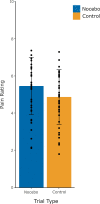Electrophysiological markers for anticipatory processing of nocebo-augmented pain
- PMID: 37494313
- PMCID: PMC10370880
- DOI: 10.1371/journal.pone.0288968
Electrophysiological markers for anticipatory processing of nocebo-augmented pain
Abstract
Nocebo effects on pain are widely thought to be driven by negative expectations. This suggests that anticipatory processing, or some other form of top-down cognitive activity prior to the experience of pain, takes place to form sensory-augmenting expectations. However, little is known about the neural markers of anticipatory processing for nocebo effects. In this event-related potential study on healthy participants (n = 42), we tested whether anticipatory processing for classically conditioned nocebo-augmented pain differed from pain without nocebo augmentation using stimulus preceding negativity (SPN), and Granger Causality (GC). SPN is a slow-wave ERP component thought to measure top-down processing, and GC is a multivariate time series analysis used to measure functional connectivity between brain regions. Fear of pain was assessed with the Fear of Pain Questionnaire-III and tested for correlation with SPN and GC metrics. We found evidence that both anticipatory processing measured with SPN and functional connectivity from frontal to temporoparietal brain regions measured with GC were increased for nocebo pain stimuli relative to control pain stimuli. Other GC node pairs did not yield significant effects, and a lag in the timing of nocebo pain stimuli limited interpretation of the results. No correlations with trait fear of pain measured after the conditioning procedure were detected, indicating that while differences in neural activity could be detected between the anticipation of nocebo and control pain trials, they likely were not related to fear. These results highlight the role that top-down processes play in augmenting sensory perception based on negative expectations before sensation occurs.
Copyright: © 2023 Blythe et al. This is an open access article distributed under the terms of the Creative Commons Attribution License, which permits unrestricted use, distribution, and reproduction in any medium, provided the original author and source are credited.
Conflict of interest statement
The authors have declared that no competing interests exist.
Figures





Similar articles
-
Neural underpinnings of nocebo hyperalgesia in visceral pain: A fMRI study in healthy volunteers.Neuroimage. 2015 Oct 15;120:114-22. doi: 10.1016/j.neuroimage.2015.06.060. Epub 2015 Jun 26. Neuroimage. 2015. PMID: 26123378
-
Nocebo hyperalgesia induced by implicit conditioning.J Behav Ther Exp Psychiatry. 2019 Sep;64:106-112. doi: 10.1016/j.jbtep.2019.03.006. Epub 2019 Mar 29. J Behav Ther Exp Psychiatry. 2019. PMID: 30952053
-
Understanding the Role of Expectancy, Anticipatory Anxiety, and Attention Bias in Nocebo Hyperalgesia: A Gaze-Contingent Attention Bias Modification Study.J Pain. 2024 Apr;25(4):946-961. doi: 10.1016/j.jpain.2023.10.016. Epub 2023 Oct 24. J Pain. 2024. PMID: 37879546 Clinical Trial.
-
Nocebo and the contribution of psychosocial factors to the generation of pain.J Neural Transm (Vienna). 2020 Apr;127(4):687-696. doi: 10.1007/s00702-019-02104-x. Epub 2019 Nov 22. J Neural Transm (Vienna). 2020. PMID: 31758266 Review.
-
The Underestimated Significance of Conditioning in Placebo Hypoalgesia and Nocebo Hyperalgesia.Pain Res Manag. 2018 Jan 28;2018:6841985. doi: 10.1155/2018/6841985. eCollection 2018. Pain Res Manag. 2018. PMID: 29670678 Free PMC article. Review.
References
-
- Butz MV, Sigaud O, Gérard P. Anticipatory Behavior: Exploiting Knowledge About the Future to Improve Current Behavior. In: Butz MV, Sigaud O, Gérard P, editors. Anticipatory Behavior in Adaptive Learning Systems: Foundations, Theories, and Systems. Berlin, Heidelberg: Springer Berlin Heidelberg; 2003. p. 1–10.
Publication types
MeSH terms
LinkOut - more resources
Full Text Sources
Miscellaneous

